Stomach: Bariatric Surgery
Laparoscopic Adjustable Gastric Banding (LAGB)
Procedure
- Expose Left Crus at the Angle of His
- Dissect the Gastrohepatic Ligament to Enter the Lesser Sac
- Place Band Around Proximal Stomach
- Medial-to-Lateral Direction (45-Degree Angle to Left Shoulder)
- Inferior-to-Superior Slant
- Pull Tubing Externally & Secure to the Subcutaneous Port
Complications
- Band Slippage
- Herniation of Stomach Above the Band
- UGI: Fundus Above Band
- Band on XR Should Be at 45-Degree Angle (90-Degree or More is Indicative of Slippage)
- Tx: Deflate Band (Remove Saline) & Surgically Remove
- Gastric Erosion
- Erosion of the Band into the Stomach
- Presentation: Erythema & Tenderness at Port Site
- UGI: Contrast Outside of Lumen
- Tx: Remove Band & Repair Defect
- Tube Kinking
- Presentation: Difficulty Adding/Removing Fluid from Port
- Tx: Explore Under Local Anesthesia
- Band Too Tight
- UGI: Esophageal Dilation
- Tx: Deflate Band or Surgically Remove
Vertical Banded Gastroplasty (VBG)
- A Vertical Staple Line Through the Proximal Stomach with a Band Placed Around the Middle of the Stomach at the End of the Staple-Line to Create a Small Pouch
- Fallen Out of Favor
- Only 10% Maintain Weight Loss After 10 Years
- Restrictive Nature Causes Difficulty Tolerating High Fiber/Protein Diet
- Many Result to Liquid Carbs and Junk Food Causing Weight Regain
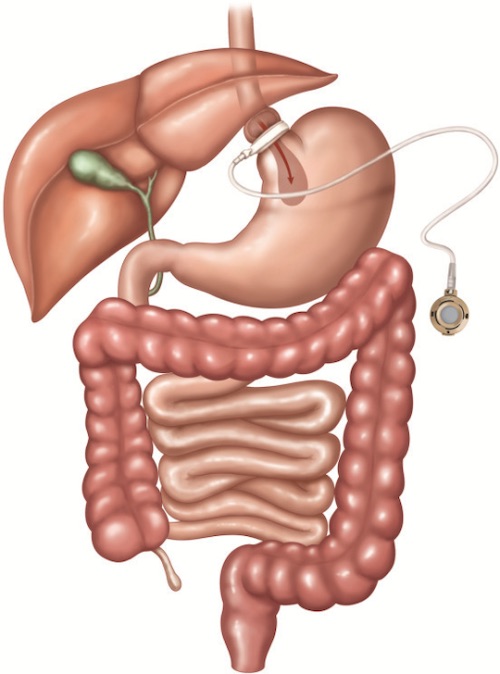
LAGB 1
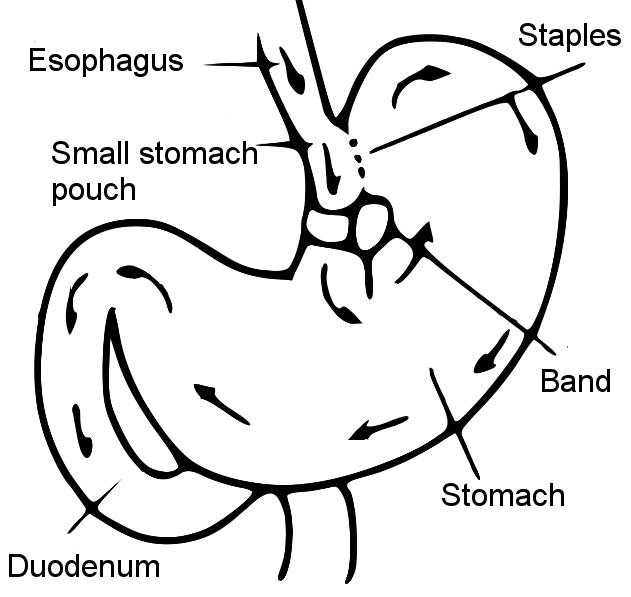
VBG 2
Laparoscopic Vertical Sleeve Gastrectomy (LVSG)
Procedure
- Divide the Short Gastric Vessels Along the Greater Curvature
- Pass Bougie Orally and Direct Along the Lesser Curvature
- Divide Stomach Along the Greater Curvature
- Start 5-6 cm from Pylorus (Obstructs if Too Close)
- Extend to Angle of His
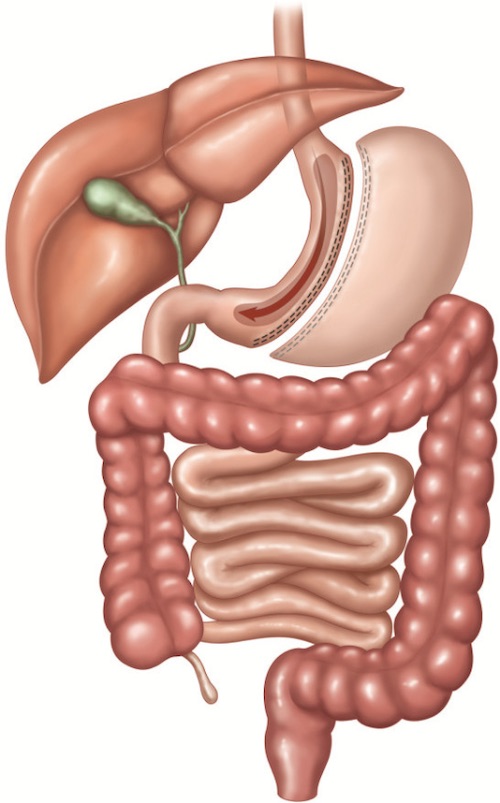
LVSG 1
Roux-en-Y Gastric Bypass (RYGB)
Procedure
- Divide Jejunum 30-50 cm (Biliopancreatic Limb) Distal to Ligament of Treitz
- Anastomose Proximal End 75-150 cm (Roux Limb) Down Distal Jejunum
- Expose Left Crus at the Angle of His
- Dissect the Gastrohepatic Ligament to Enter the Lesser Sac
- Transect Stomach to Create a 20 cc Proximal Gastric Pouch
- Anastomose Roux Limb to Gastric Pouch
- Close Mesenteric Defects
Mesenteric Defects
- Jenjuno-Jejunostomy Defect
- Petersen’s Space
- Between Roux Limb Mesentery & Transverse Mesocolon
- Transverse Mesocolon Defect
- Only Present After Retrocolic Procedures
Roux Limb Variations
- Antecolic – Roux Limb Passed Anterior to Transverse Colon
- Faster to Preform
- Retrocolic – Roux Limb Passed Posterior to Transverse Colon
- Shorter Route (Less Ischemia Risk)
- Higher Risk for Internal Hernia
Complications
- Failure & Weight Regain (15%, Long Term 35%)
- Definition: BMI > 35 or Failure to Achieve/Maintain ≥ 50% of Excess Weight Loss
- Most Often Due to Maladaptive & Noncompliant Eating Habits
- Pouch Can Stretch/Dilate from Repeated Overdistention
- Unlikely to Benefit from Revisional Surgery
- Can Be Caused by a Gastrogastric Fistula
- Anastomotic Leak (0-5%)
- Consider Barium Swallow on Postoperative Day #2
- Most Common Cause: Ischemia
- Sx: Tachycardia (First), Tachypnea, Fever & Often Have No Pain
- Any Evidence of New Onset Tachycardia Could Suggest a Leak
- Tx:
- Unstable or Early (Not Contained): Surgery
- Stable & Late (Contained): IR Drain & ABX
- Stomal/Anastomotic Stenosis (6-17%)
- Manifests When Anastomosis Diameter Narrow < 10 mm
- Presentation: Unable to Swallow Liquids
- Tx: Endoscopic Dilation
- Marginal Ulcers (0.6-16%)
- Advise All Patient to Avoid Smoking & NSAIDs
- *See Stomach: Gastrectomy
- Gastrogastric Fistula (1-2%)
- Fistula Between Stomach Pouch & Stomach Remnant
- Presentation: Marginal Ulcers, Pain, Bleeding or Weight Gain
- Tx: Endoscopy vs Surgery
- Internal Hernia (3-5%)
- *See Small Intestine: Internal Hernia
- Most Common Cause of SBO after RNY (Not Adhesions)
- Herniated Bowel Through Internal Mesenteric Defect
- See Mesenteric Swirl on CT
- Cause: Poor Closure of Defects
- Increased Risk in Laparoscopic Surgery (Less Adhesions > More Mobility)
- Most Common Defect: Transverse Mesocolon (Less With Antecolic Limb)
- Tx: Surgery
- Gallstones
- Cause: Stasis & Increased Calcium/Mucin Secretion
- Rapid Weight Loss Increases Lithogenicity of Bile
- Asymptomatic Gallstones are Common but Symptoms are Rare
- Difficult to Preform ERCP for Choledocholithiasis After RYGB Due to Altered Anatomy
- May Require Surgical Gastrostomy into Remnant to Pass the Endoscope
- Some Recommend Prophylactic Cholecystectomy at Time of Original Surgery (Controversial)
- Cause: Stasis & Increased Calcium/Mucin Secretion
- Dumping Syndrome
- Candy Cane Roux Syndrome
- Excessively Long Blind Afferent Roux Limb at the Gastrojejunostomy
- Presentation: Postprandial Pain Relieved by Vomiting
- Dx: UGI or Endoscopy
- Tx: Surgical Revision
- Gastric Remnant Distention
- Risk for Rupture
- Tx: Emergent Gastrostomy Tube for Decompression
- B12 Deficiency & Iron-Deficiency Anemia
- Medication Absorption Changes:
- Increased Absorption:
- Digoxin
- Lithium
- Penicillin
- Atorvastatin
- Decreased Absorption:
- Phenytoin
- Erythromycin
- Coumadin
- Ampicillin
- Tamoxifen
- Cyclosporine
- Levonorgestrel
- Imatinib
- Tacrolimus
- Increased Absorption:
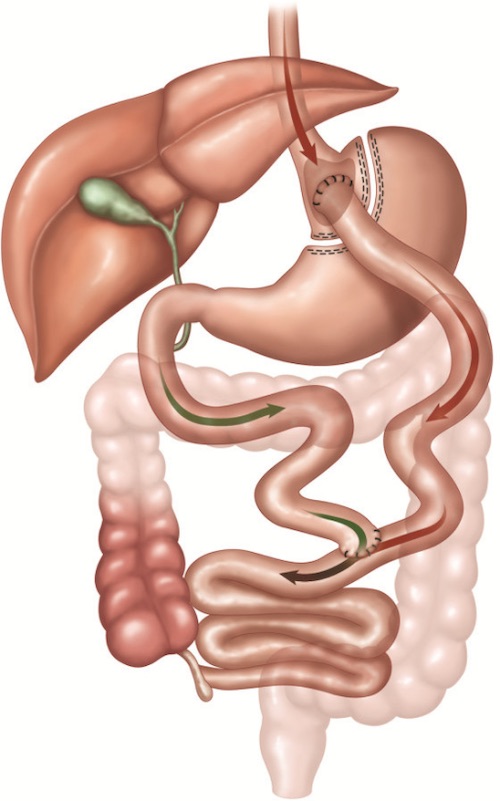
RYGB 1
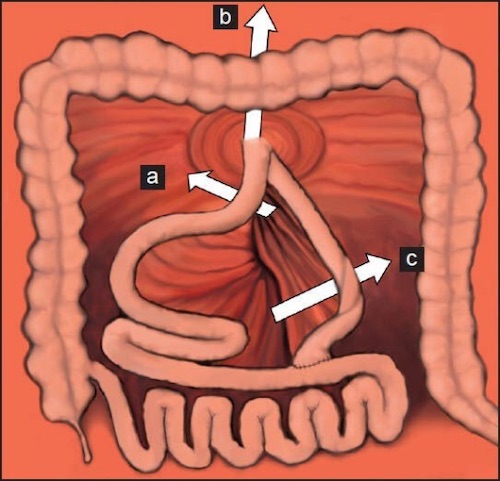
Mesenteric Defects; (a) Petersen’s Space, (b) Transverse Mesocolon Defect, (c) Jejuno-Jejunostomy Defect 3
Jejunoileal Bypass
Procedure
- Divide Proximal Jejunum at 35 cm
- Anastomose to Proximal End to Ileum, 10 cm From Ileocecal Valve
Basics
- No Longer Preformed
- High Complication Rate – Liver Cirrhosis, Kidney Stones, Osteopenia & Malnutrition
- Reoperate if Found
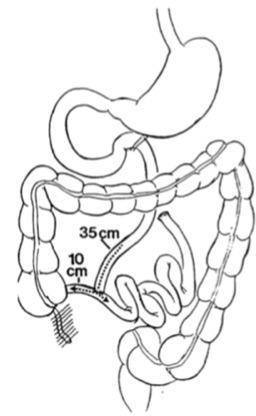
Jejunoileal Bypass 4
Biliopancreatic Diversion with Duodenal Switch (BPD-DS)
Procedure
- Preform a Sleeve Gastrectomy
- Divide Ileum 250 cm From Ileocecal Valve
- Anastomose Proximal End (Ileoileostomy) 100 cm from Ileocecal Valve
- Divide Duodenum 3-4 cm Distal to Pylorus
- Anastomose Roux Limb to Duodenum (Duodenoileostomy)
- Close Mesenteric Defect
Considerations
- May Require Two-Stage Procedure if Extremely High BMI > 70
- Stage 1: Sleeve Gastrectomy
- Stage 2: Diversion & Switch After 1 Year of Weight Loss
- Duodenal Switch Leaves the Pylorus Intact
- Biliopancreatic Diversion Alone Has Roux Limb Anastomose to Stomach
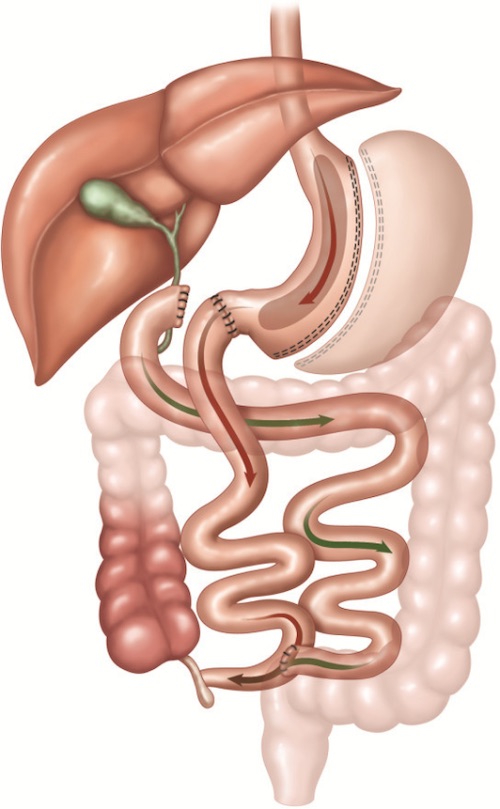
BPD-DS 1
References
- Neff KJ, Olbers T, le Roux CW. Bariatric surgery: the challenges with candidate selection, individualizing treatment and clinical outcomes. BMC Med. 2013 Jan 10;11:8. (License: CC BY-2.0)
- Friberg J, Fruitsmaak S. Wikimedia Commons. Public Domain.
- Izadpanah A, Izadpanah A, Karunanayake M, Petropolis C, Deckelbaum DL, Luc M. Abdominal compartment syndrome following abdominoplasty: A case report and review. Indian J Plast Surg. 2014 May;47(2):263-6. (License: CC BY-NC-SA-3.0)
- Sylvan A. Wikimedia Commons. (License: CC BY-SA-4.0)